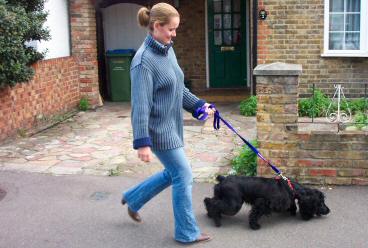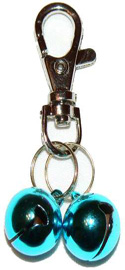Dogs pulling on the lead How to teach your dog to walk to heel
Dogs Pulling on the Lead
Firstly we should understand why a dog pulls, it is either:
Anticipation: "Yeah we going to the park" this one normally does not pull on the way back from the park! but is an absolute nightmare getting there.
Control: This one wants to control most things, from controlling the lead to the speed you walk. This control freak normally pulls at all times both to and from the park.
Fear: Only pulls on the way back from the park so he can get back to the safety of the house. This type of puller normally suffers from traffic noise, lead aversion or agoraphobia.
The Lead: Strangely enough many dogs pull because of the type of lead you have. Let me explain by quoting one of the principal laws of physics. Also known as Newton's Law.
 For every action, there is an equal and opposite reaction. These forces are called action and reaction and are the subject of Isaac Newton's third law of motion. Simply put for every Ying there is a Yang for every pull there is a push. We generally have shortish leads and when the dog pulls we immediately pull him back.
For every action, there is an equal and opposite reaction. These forces are called action and reaction and are the subject of Isaac Newton's third law of motion. Simply put for every Ying there is a Yang for every pull there is a push. We generally have shortish leads and when the dog pulls we immediately pull him back.
There you have it! You can't fight Newton's Law, and Physics, according to any scientist are immutable. So you pull the dog back and physics takes over, he just has to push against your pull and bingo you have a nightmare lead walking. Isn't it strange that often dogs walk perfectly well off the lead but are an absolute nightmare when you clip the lead on.
I knew all that time at school listening to my physics teacher (I think we called them science masters), would prove useful one day. Because of my beliefs I designed and developed a lead that would be the correct length for training dogs in all disciplines. Not just to stop pulling but for many other problems as well, young Isaac would have been proud of me.
All my leads are made of cushion web which makes them incredibly comfortable.They are five feet eight inches long with a couple of innovations, such as a D Ring for the Jingler, (more later) and an O ring at the handle end which is very handy for tying on your poo bags or putting the lead around your shoulder when the dog is off lead.
It is also handy for clipping the dog to a lamppost or halving the size of the lead if you are in a busy area such as a high street. This is what you will need and the technique i have created to stop your dog pulling on the lead:
1. A quality reasonably wide collar. I now manufacture my own collars that are a similar material and feel to the lead and the same colours (see website) make sure the collar is not thin, or rolled as they bite into the neck.
You are also going to require a Jingler, which is a simple device which uses sound therapy to make the dog concentrate on your commands and actions.

Simply put a jingler tells the dogs when it has done something wrong, the opposite of a clicker that tells the dog when it has done something right. in the end dogs require to know what is right and what is wrong.
I designed and developed this personally. see details It goes on the end of the lead near the collar. This focuses the dog by using sound therapy. Never use a check or choke chain this is a barbaric method of lead control, and can cause long-term damage. You will no longer need a Harness or Halti or any other form of restraint. These devices do not train the dog to walk to heel they only inhibit it. My method trains correct heel work, given time you should be able to get the dog walking to heel without the lead. “Never of course on roads where there is any traffic”.
2. A suitable lead at least 5.5 feet long. Make sure your dog is always on your left hand side. Hold the lead in your right hand, the best way is to put the loop over your thumb and close the palm of the hand over the loop. Then your left hand holds the lead between 8 to 20 inches up from the collar, depending on the height of the dog. Step off with your left foot saying “Heel”. When the dog pulls ahead see the movement then simply drop the lead out of the left hand but holding still in the right hand, thus allowing the dog to go forward.
As the dog goes forward simply turn 180% and go back the way you came. Giving a number of small corrective waves that is moving the hand up and down creating three small waves that go down the lead activating the jingler with your right hand, make sure you do not use your left hand to activate the Jingler only the right one. Almost like an ABS braking system on a car.
Then grab the lead again with the left hand and continue forward (DO NOT ISSUE ANY COMMAND AT THIS TIME). This is vitally important for this type of behaviour modification; you want to make the dog think that its own actions are causing the reaction, i.e. he pulls it causes you to turn and the Jingler to activate. Just turn and jingle every time the dog moves forward.
Repeat this until dog starts walking to heel. Normally takes five to ten minutes, if you are following the correct technique. Then start praising and treating the dog for the correct position, in other words “what a good boy” with lots of praise and reassurance. Most people make the mistake of saying heel when the dog is out in front or behind, which of course is teaching the dog the wrong position when you issue the command.
You may have to remind him using the same technique over the next few weeks, but I guarantee you will find those walks so much easier almost immediately. If you find you are struggling with the techniques then it may be prudent to purchase my DVD which breaks the whole processes down into easily followed visual instructions and prompts. It also covers jumping up,the sit stay which is the basis for the recall and the "OFF" command which changes the way dogs perceive you, and this makes for happier and better behaved pet. See the Alpha Myth.
The DVD below shows me working with a young working Cocker Spaniel. I
train him to walk to heel in less that 1 minute. No Halti's , Check Chains. or Chest Harnesses. And you can remove the bells after a while and he still should walk to heel. Simple and incredibly effective.
This article was written by ©Stan (The Original Doglistener). A professional full time Dog Behaviourist and Obedience Trainer.
You can visit his website at www.doglistener.co.uk for more articles and training information.
You may freely distribute this article and any photographs or save to any electronic media as long as they are only used within the article and it is left intact. It must include the copyright box above. Please let me know out of courtesy where and when you publish. E.mail will suffice. including the link back to your site.
© Stan Rawlinson
November 2009
